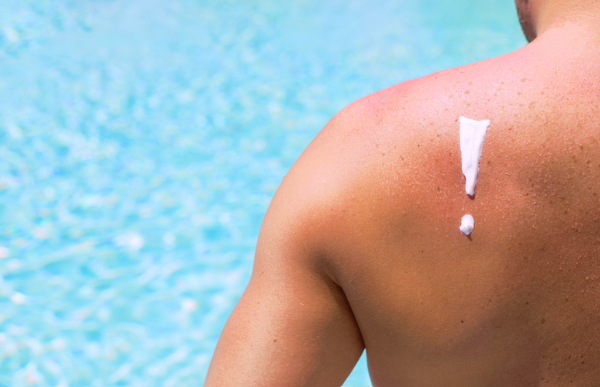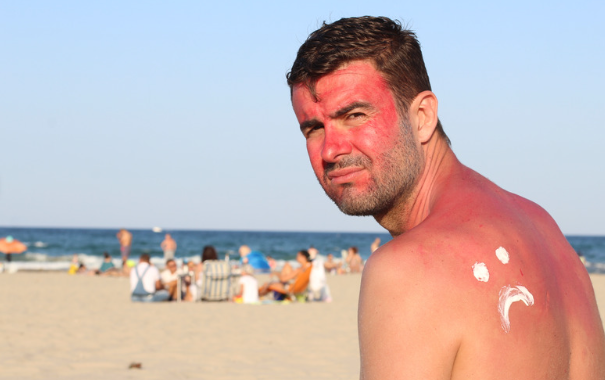
What are the symptoms of sun poisoning?
Sun poisoning is a serious condition resulting from prolonged exposure to ultraviolet radiation from the sun. It damages skin cells, which leads to more than just a bad sunburn.
Quick links:
We'll teach you how to spot the symptoms of sun poisoning and what to do next.
What is sun poisoning?
Sun poisoning (also called polymorphic light eruption) is a severe form of sunburn caused by unprotected exposure to ultraviolet (UV) radiation from the sun. It goes beyond a mild pinkish burn. Sun poisoning occurs when intense UV rays penetrate and damage unprotected skin cells, triggering an extreme inflammatory reaction throughout the body.
Rather than just localized redness, sun poisoning brings on symptoms such as blistering skin, chills, nausea, and extreme fatigue. These systemic effects can appear within 15 minutes of overexposure as the body releases inflammatory chemicals in response to the radiation. This full-body reaction can make a person feel extremely ill.
Without proper care, sun poisoning is more than just a bad burn—it can have serious long-term consequences. That's why it's crucial to recognize the symptoms early and seek treatment.
What are the common symptoms of sun poisoning?
Sun poisoning causes a range of symptoms beyond a typical sunburn. You should recognize the warning signs to get the right treatment. The most common symptoms include:
- Skin redness and blistering
- Pain and tingling
- Swelling
- Headache
- Fever and chills
- Nausea
- Dizziness
- Dehydration
- Allergic reaction
Skin redness and blistering
The most visible symptom of sun poisoning is the severe redness and inflammation of exposed skin. The redness will be intense, often appearing as a "lobster-like" burn. As UV radiation damages the skin's outer layers, painful fluid-filled blisters begin to form on the reddened areas. These blisters can rupture and ooze, further damaging the skin.
The redness extends deeper than a typical mild sunburn due to the level of tissue and cell damage. Skin may also feel hot to the touch and be extremely painful.
Pain and tingling
Sun poisoning causes severe pain in the affected areas of the skin. The burning sensation can feel much worse than a typical sunburn, and the skin will be tender. There may also be a tingling or prickling feeling, as UV damage affects the nerve endings in the skin.
Even the slightest pressure, friction from clothing, or air movement can worsen the pain. This level of discomfort is a key indicator that the sunburn has reached the point of sun poisoning.
Swelling
Another severe symptom is swelling of the sunburned skin, beyond just minor puffiness. The inflammation reaches deeper into the skin tissue which causes fluid retention and swollen wounds. Due to disrupted barriers in the skin, fluid leaks into the spaces between cells, leading to severe swelling. The swelling is often most pronounced where blisters have formed.
Even areas without blisters can have major swelling, making the skin appear stretched, shiny, and swollen as fluid accumulates. The swelling can become severe enough to cut off circulation and inhibit movement if left untreated.
Headache
A throbbing and intense headache is also one of the key signs of sun poisoning. This happens as inflammation and fluid disturbances affect the brain and meninges. Headache pain often sets in soon after overexposure. The headache resembles migraine pain, involving severe throbbing localized on one or both sides of the head.
Headache pain can worsen with exposure to light or noise due to heightened sensitivity. This symptom serves as a systemic indicator that the body is under duress from the inflammatory reaction to radiation damage. Seeking treatment for the headache as well as the sunburn is vital.
Fever and chills
Sun poisoning triggers an inflammatory response and fluid shifts similar to an infection, so fever commonly occurs. Body temperature can spike to 101-104°F soon after overexposure as homeostasis mechanisms are disrupted. In conjunction with fever, chills often set in as well.
Chills may range from mild feelings of being cold to severe shivering fits paired with a high body temperature. Chills happen because of circulation changes and malfunctions in temperature regulation centers. These symptoms require medical attention to get the body back into equilibrium when sun poisoning strikes with such intensity.
Nausea
Sun poisoning can cause gastrointestinal distress in the form of nausea and vomiting. Inflammatory molecules released in response to extensive skin cell damage can irritate the stomach lining and digestive tract. The body's effort to modulate temperature and circulatory disturbances also disrupts enteric nervous system function.
Nausea may prevent the person from keeping down any food or fluids, which can complicate treatment. Anti-nausea medication is often necessary so that rehydration therapy can begin.
Dizziness
Another common symptom is dizziness and lightheadedness. This happens as the cardiovascular system and blood flow are disrupted by the body’s inflammatory response and fluid shifts. Blood pressure drops, and circulation has trouble self-regulating. Less blood reaching the brain then causes episodes of near-fainting dizziness, especially when moving from lying to sitting or standing.
There may also be a general wooziness and difficulty concentrating due to compromised brain perfusion. Dizziness forces the person to remain stationary, as any position changes could lead to injury.
Dehydration
Fluid loss from blisters and inflamed tissue results in dehydration and decreased blood volume. Vomiting and fever contribute to further water and electrolyte losses.
The early signs of dehydration include excessive thirst, dry mucous membranes, decreased urine output, rapid heart rate and breathing, and lightheadedness. If not corrected with urgent fluid resuscitation, severe dehydration can lead to organ damage, seizures, shock, and death. A vital part of sun poisoning care is monitoring hydration status.
Allergic reaction
In some cases, sun poisoning can initiate an allergic reaction, especially in people with sensitive skin. This allergic response may present similarly to symptoms of anaphylaxis caused by food or drug allergies. Signs of a sun allergy include:
- Hives
- Itchy rashes
- Swelling of the lips or face
- Wheezing or shortness of breath
- Chest tightness
- Changes in voice
- Lightheadedness
These allergy symptoms often set in rapidly, can be life-threatening, and require emergency treatment. Any neurological, respiratory, or circulatory changes after UV exposure should be evaluated immediately to rule out allergic reactions on top of sun damage.
What causes sun poisoning?
Too much UVB radiation from sunlight causes sun poisoning. UVB rays penetrate deep into unprotected skin, causing inflammation and damage in the form of severe sunburn.
The body reacts by releasing compounds that expand blood vessels and activate pain receptors, triggering a biological disaster response.
What to do for sun poisoning?
More severe symptoms of sun poisoning should be treated at the hospital, while milder cases may be successfully treated at home. If in doubt, consult your doctor.
Treat sun poisoning at home
Home treatment should focus on soothing symptoms and monitoring for complications needing medical care. Key steps include:
- Apply aloe vera gel liberally to damaged skin to aid healing and provide cooling relief.
- Protect skin from additional sun exposure by staying indoors or wearing protective clothing and sunscreen if going outside.
- Cool inflamed skin with loose lightweight clothing, cold compresses, cold baths, or hydrocortisone creams.
- Stay hydrated by drinking plenty of water and electrolyte drinks.
- Take over-the-counter NSAID pain relievers to relieve aches and pains.
- Gently clean blistered or oozing skin and apply antibiotic ointment to prevent infection.
- Get lots of rest and eat a nutritious, light diet to support healing.
Carefully monitor for severe symptoms such as high fever, low blood pressure, fainting, or allergic reactions that indicate emergency care is needed. Seek medical attention if symptoms don't start significantly improving within 1-2 days.
Seek medical care
For severe sun poisoning cases, go to the nearest hospital ER or urgent care clinic. Typical medical treatments include:
- IV fluid rehydration therapy to restore fluid balance. This is vital for severe dehydration.
- Medications (steroid creams, pain relievers, and antibiotics) tailored to specific symptoms and complications risks.
- Wound care includes gentle cleaning and antimicrobial dressings to prevent skin infection.
- Ongoing monitoring for high-risk cardiac, kidney, or electrolyte abnormalities.
Close medical supervision is crucial if complications arise. Follow your doctor’s orders to prevent permanent effects.
How to prevent sun poisoning?
Prevent sun poisoning with these safe sun practices:
- Use broad-spectrum sunscreen with a sun protection factor (SPF) of 30 or higher. This helps shield the skin from both UVA and UVB rays.
- Apply a generous amount of sunscreen to all exposed skin at least 20 minutes before going outdoors. Reapply every two hours, especially after towel drying, sweating, and swimming.
- Avoid direct sunlight between 10 am-4 pm, as the sun's rays are most intense during that time.
- Check the daily ultraviolet radiation intensity for your area with our user-friendly UV index tool, and seek shade during more intense days to protect your skin.
- Wide-brimmed hats and sunglasses with UV protection offer additional protection for the face, neck, and eyes.
- Tightly woven, full-coverage clothing (for example, our swim dresses or long-sleeve rash guards) provides an extra layer of defense against UV radiation.
- Gradually increase the amount of time spent in the sun to help the skin build a slight tolerance and reduce the risk of severe sunburn or sun poisoning.
- Make sure to avoid burning, as each burn can increase the risk of skin cancer and long-term skin damage.
- Carry fluids for dehydration and cool compresses, especially in hot weather or when spending extended periods of time in the sun.
Can you die from sun poisoning?
Severe sun poisoning can become life-threatening without prompt medical treatment. It can progress to heat exhaustion, heatstroke, systemic infections, or organ failure—all potentially fatal.
The extensive skin cell damage from sun poisoning raises the long-term risk of developing malignant melanoma and other deadly skin cancers.
What are the symptoms of mild sun poisoning?
Here are the most common symptoms of mild sun poisoning:
- Redness. Skin appears brightly or darkly red, even after initial sunburn fading.
- Pain. Tenderness or burning pain may be in affected areas.
- Small blisters. Fluid-filled blisters start forming on reddened skin.
- Warmth and minor swelling. Skin feels hot and slightly puffy to the touch.
- Low-grade fever. Slight increase in body temperature up to 100°F.
- Headache. Mild throbbing head pain.
- Nausea. Low-level queasiness or loss of appetite.
- Fatigue. Increased tiredness and lethargy.
Stay safe with Swimzip’s protective gear
SwimZip's sun-protective swimwear keeps your skin protected and does it with fashion-forward style. Using innovative fabrics rated UPF 50+ for maximum UV protection, these garments block 98% of UVA and UVB radiation to offer a high level of defense against sun damage.
These garments are not only a practical and effective line of defense but also come in different styles that cater to comfort and fashion preferences.
With SwimZip, you will get the highest quality sun-protective clothing that prioritizes skin health without compromising style.
Sun poisoning FAQ
What are the differences between sunburn and sun poisoning?
Sunburn is a common skin condition caused by overexposure to UV radiation, resulting in red, painful skin. Sun poisoning, on the other hand, is a more severe reaction to the sun, characterized by symptoms such as fever, chills, nausea, and dizziness.
What is the fastest way to get rid of sun poisoning?
The fastest way to alleviate sun poisoning symptoms is to seek shade, drink plenty of water, apply cool compresses to the affected area, and take over-the-counter pain relievers (ibuprofen, for example). Severe cases may require medical treatment.
Will sun poisoning heal on its own?
Mild cases of sun poisoning may improve on their own with proper care and time. However, severe sun poisoning may require medical intervention to manage symptoms and prevent complications.
Does drinking water help with sun poisoning?
It is crucial to stay hydrated in managing sun poisoning. Dehydration is a common complication of sun poisoning, so drinking plenty of water can help replenish lost fluids and support the body's recovery.
When is the risk of sunburn the highest?
The riskiest period for extreme sunburn is during peak sun hours (from 10 AM to 4 PM) when sunlight hits at the most direct angle. Risk also dramatically increases at high altitudes closer to the sun’s rays and with reflections off water, sand, or snow.
What is the difference between heat rash and sun poisoning?
Heat rash results from clogged sweat glands during hot weather, and does not directly stem from sun damage. It causes small red bumps and irritation which may itch fiercely. Sun poisoning is a severe reaction to excessive sun exposure, leading to symptoms beyond those of a typical sunburn.
What is a sun hangover?
A "sun hangover" is feeling sick the day after getting too much sun, even without drinking alcohol. Symptoms like bad headaches, nausea, dehydration, and extreme tiredness happen because overexposure to UV rays damages the skin and disrupts fluid balance. Essentially, the body reacts severely to excessive sunlight, mimicking a post-drinking hangover.
What type of skin is the most prone to sunburn?
The skin type most vulnerable to sunburn is pale or fair skin that lacks melanin pigment. Those with red or blond hair and freckles often have little protective melanin. Such fair complexions are damaged by smaller amounts of UV rays, versus olive, brown, or black skin with more abundant dark pigment.
What are the severe sunburn symptoms?
Severe sunburn goes beyond just redness, and progresses into large painful blisters, along with symptoms such as fever over 100 degrees, shaking chills, very bad headache, nausea, dizziness, and elevated heart rate
What is the difference between sun poisoning vs. sunburn?
Sunburn is a superficial skin condition that results from exposure to UV radiation that causes redness and discomfort. Sun poisoning is a more severe reaction to sun exposure that is characterized by a range of symptoms, including nausea, headaches, fever, and blistering. In some cases, sun poisoning can require medical attention, and may lead to permanent skin damage.





Leave a comment
This site is protected by hCaptcha and the hCaptcha Privacy Policy and Terms of Service apply.